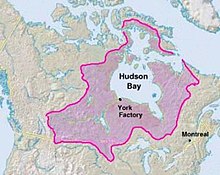Pemmican war
The Pemmican War (English Pemmican War ) was a conflict between Hudson's Bay Company and North West Company . It was fought from 1815 to 1820 mainly in the Red River Colony in what is now the Canadian provinces of Manitoba and Saskatchewan .
background
Hudson's Bay Company (HBC) and North West Company (NWC) lived almost exclusively from the fur trade, the much older HBC based on a fur trade monopoly of the English crown for Rupert's land , the NWC traded in the rest of the northwestern part of today's Canada. To do this, they obtained large quantities of pemmican , which is made from buffalo meat , and which was needed in large quantities by the fur hunters in the poor north as a trade item. The pemmican was sourced in the northernmost part of the American prairie , now the southern parts of Manitoba, Saskatchewan and Alberta as well as North Dakota and northern parts of South Dakota and Minnesota .
The NWC had its headquarters in Montreal and was accordingly frankofon. Their main supplier for pemmican was the also (mainly) Francophone mixed ethnic group of the Métis , who had their main settlement area at the confluence of the Assiniboine and the Red River (The Forks) . However, this area belonged to Ruperts Land, the area of the fur trade monopoly of the HBC, even if the Forks did not trade fur, but pemmican.
In Scotland , since the end of the 18th century, with the introduction of large-scale sheep farming, many farmers have been driven out of the high and lowlands (see Highland Clearances ). In 1809, Lord Selkirk and two other Scots bought into the HBC to open up new settlement opportunities for the farmers in the Company's areas.
Furthermore, both fur trading companies had suffered considerable losses due to the blockade of the trade routes to Europe during the Napoleonic continental blockade from 1806 to 1813, and were thus under increased economic pressure.
Course of events
In 1811, at Selkirk's instigation, the HBC decided to found the Red River Colony in the northern prairie. It was not only intended to benefit the Scottish new settlers, but was also a somewhat obvious attempt to cut off the NWC, located in eastern Montreal, from their supply areas for the pemmican and to displace their suppliers, the Métis. Logically, the first settlement was then planned at The Forks , the center of the Métis settlement area. In 1812 the Fort Douglas trading post was built there under manager Miles Macdonell and the first Scottish settlers settled there.
In the spring of 1813 there was a shortage of food among the new settlers and Macdonell forbade the export of any food from the new colony, the so-called Pemmican Proclamation , and thus also the traditional sale of pemmican by the Métis to the NWC. Naturally, this was not very pleased and burned down Fort Douglas and the surrounding buildings. The post was rebuilt, but there were repeated clashes. In 1816, Selkirk sent the new administrator Robert Semple with an order calling for the fighting to cease and thus the recognition of the HBC's administrative power. Semple captured Fort Gibraltar , the NWC's trading post at The Forks . In the attempt of a group of NWC employees under Cuthbert Grant , The Forks to get around by land, it came to the battle of Seven Oaks . Fort Douglas was destroyed a second time and the new settlers were driven out, Semple and 20 of his people were killed in the battle.
Selkirk then sent 100 soldiers who were able to bring about peace on the Red River by 1819. Smaller disputes in the fur trade areas on Lake Athabasca dragged on until 1820 (see also Colin Robertson ).
Aftermath
Selkirk had gambled away his entire fortune and died in 1820 at the age of 49. Both companies were financially bad after 1819; They merged in 1821, avoiding further competition. Is what officially fusion part (merger) was called, called the acquisition by the HBC, whose name was retained. From this point of view, the HBC won the pemmican war, even if it paid dearly.
The areas of the two fur trade monopolies were combined in the merged company as Northwest Territories. In 1869 the Canadian Dominion , founded two years earlier, acquired the territories from the HBC, numerous provinces and territories were split off from this area, which makes up two thirds of present-day Canada, most recently Nunavut in 1999.
Despite the peace, only a few Scots settled at The Forks , but they lived amicably with the Métis, who now supplied the pemmican for the united fur traders. Half a century later, the Scots and Métis fought together in the Red River Rebellion for the new province of Manitoba, from which the Métis could hardly benefit because of the declining buffalo populations , which they followed west into what is now Saskatchewan.
Historical classification
The Battle of Seven Oaks is considered a unifying event for the Métis, who later fought for their own province in the Red River and Northwest Rebellions under their leader Louis Riel , but ultimately failed. The Pemmican War is also the first armed conflict in which the different attitudes of French and Anglo-Canadians to the Métis emerged. Only since the 1980s has a common, more neutral historical view of the pemmican war and the two rebellions among the two main language groups of the country established itself in Canada.
Web links
- Lord Selkirk . In: Dictionary of Canadian Biography . 24 volumes, 1966–2018. University of Toronto Press, Toronto ( English , French ).
- Robert Semple . In: Dictionary of Canadian Biography . 24 volumes, 1966–2018. University of Toronto Press, Toronto ( English , French ).
- The Selkirk Concession ( Memento of February 10, 2006 in the Internet Archive ) (English).

